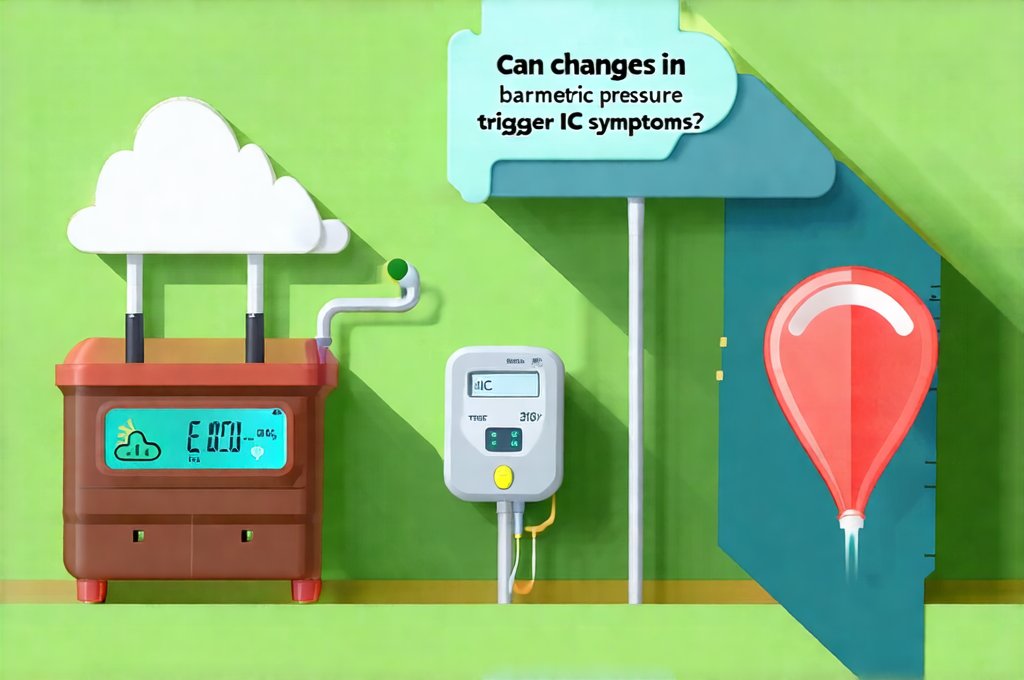Changes in barometric pressure – essentially, shifts in the weight of the atmosphere – are a common part of daily life. We experience them with changing weather patterns, altitude changes (like flying or driving through mountains), and even seasonal transitions. For many people, these fluctuations go unnoticed. However, for individuals living with Interstitial Cystitis (IC) – also known as Bladder Pain Syndrome – these seemingly innocuous shifts can trigger a distressing flare-up of symptoms. The link between barometric pressure and IC symptom exacerbation is often reported anecdotally by patients, yet the underlying mechanisms are complex and not fully understood by the medical community. This article will delve into this fascinating connection, exploring what we currently know about how changes in atmospheric pressure might affect bladder function and pain levels in people with IC, as well as strategies for coping with these fluctuations.
The experience of symptom flares related to weather changes is surprisingly common across many chronic illness conditions – fibromyalgia, migraine, arthritis, even certain mental health disorders often see increased symptoms during shifts in barometric pressure. This suggests there’s a broader physiological sensitivity at play that isn’t unique to IC sufferers. While the exact reasons for this remain under investigation, it likely involves the body’s nervous system, inflammatory responses, and potentially even subtle changes in fluid balance. Understanding these potential connections can help validate the experiences of those living with IC and encourage further research into effective management strategies beyond traditional medical treatments. It’s crucial to remember that individual experiences vary significantly; what triggers a flare for one person may not affect another.
The Science Behind Barometric Pressure and Pain
Barometric pressure affects our bodies in several ways, even if we don’t consciously realize it. Our bodies are essentially sealed containers filled with fluids and gases, striving to maintain internal equilibrium. When external atmospheric pressure changes rapidly, this can create imbalances within us. For instance, a drop in barometric pressure (often preceding rain) causes air to expand – potentially leading to increased pressure within joints, tissues, and even organs. This expansion can irritate sensitive nerve endings, triggering pain signals. In the context of IC, it’s theorized that changes in atmospheric pressure might impact the bladder wall itself, or influence the sensitivity of nerves surrounding the bladder, contributing to the familiar symptoms of urgency, frequency, and pain.
The role of the autonomic nervous system (ANS) is also being investigated. The ANS controls involuntary bodily functions like heart rate, digestion, and – crucially – bladder function. Barometric pressure changes can impact the delicate balance of the ANS, potentially leading to increased nerve sensitivity and heightened pain perception. Furthermore, some research suggests that fluctuations in atmospheric pressure may influence inflammation levels within the body. Chronic inflammation is often implicated in IC symptomology, so exacerbating this inflammatory response could contribute to flare-ups. It’s important to note that this isn’t about a direct physical pressure change on the bladder necessarily; it’s more about how these external shifts affect internal physiological processes.
Finally, there’s the influence of atmospheric electricity. Changes in barometric pressure are often accompanied by changes in electrical charges in the air. These subtle electrical fluctuations can potentially affect nerve function and pain perception, adding another layer of complexity to this relationship. While still largely speculative, some researchers believe that these electrical shifts may play a role in triggering IC symptoms for those with heightened neurological sensitivity.
Potential Mechanisms Linking Pressure Changes to IC Symptoms
The pathophysiology of IC is already complex and multifactorial; adding barometric pressure fluctuations into the equation creates an even more challenging puzzle. One leading theory revolves around the concept of mast cell activation syndrome (MCAS). Mast cells are immune cells that release histamine and other inflammatory mediators in response to various triggers. Some individuals with IC also experience MCAS, meaning their mast cells are overly sensitive and easily activated. It’s hypothesized that changes in barometric pressure could act as a trigger for mast cell activation, leading to the release of these inflammatory substances and subsequent bladder irritation.
Another potential mechanism centers on the pelvic floor muscles. These muscles play a crucial role in supporting bladder function and maintaining continence. Changes in atmospheric pressure might influence muscle tension and nerve sensitivity within the pelvic floor, contributing to pain and dysfunction. A tense or spasming pelvic floor can exacerbate IC symptoms by putting additional pressure on the bladder. Furthermore, research suggests that individuals with chronic pain conditions often have altered sensory processing – meaning their brains interpret signals differently than those without chronic pain. This heightened sensory awareness could make them more susceptible to noticing and being affected by barometric pressure changes.
It’s also crucial to consider the impact of stress. Barometric pressure changes can be associated with weather events that are inherently stressful for some people—think about impending storms or extreme temperatures. Stress is a well-known trigger for IC flares, so the psychological component should not be overlooked. The combination of physical and emotional factors likely contributes to the overall experience of symptom exacerbation.
Identifying Your Personal Triggers
Understanding your individual sensitivity to barometric pressure changes is the first step towards managing them. – Keep a detailed symptom diary: Record your symptoms daily, noting any correlation with weather patterns or barometric pressure shifts. Many weather apps now display historical and real-time barometric pressure data, making tracking easier. – Pay attention to pre-storm sensitivity: Do you notice an increase in symptoms before storms arrive? This can indicate a strong connection between falling barometric pressure and your flares. – Note altitude changes: Did traveling or going to higher altitudes exacerbate your symptoms? Altitude affects atmospheric pressure, so this can be another indicator of sensitivity.
Beyond tracking, consider exploring other potential triggers that might coincide with weather changes. For example, are you more likely to experience flares during cold weather, which often leads to increased muscle tension and decreased physical activity? Or do seasonal allergies worsen alongside barometric pressure fluctuations, potentially contributing to inflammation? Identifying these co-occurring factors can help refine your management strategies. Remember that everyone is different; what triggers a flare for one person may not affect another.
Coping Strategies During Pressure Changes
While we can’t control the weather, we can take steps to mitigate its impact on our IC symptoms. – Stay hydrated: Adequate hydration helps maintain bladder health and can potentially reduce sensitivity. – Manage stress: Practice relaxation techniques like deep breathing exercises, meditation, or yoga to help calm your nervous system. – Maintain a consistent routine: Regular sleep patterns, mealtimes, and physical activity can help stabilize your body’s internal environment. – Warmth is key: If cold weather exacerbates your symptoms, use heating pads, warm baths, or dress in layers to stay comfortable.
- Consider supportive garments: Compression clothing or pelvic floor support devices might offer some relief by providing stability and reducing pressure on the bladder. –Communicate with your healthcare provider: Discuss your concerns about barometric pressure sensitivity and explore potential treatment options for managing flares. This could include adjusting medication dosages, exploring alternative therapies, or developing a personalized coping plan.
If you find that changes in weather are triggering UTI-like symptoms, it is important to learn more can weather changes trigger and how they impact your body. It’s also helpful to explore if hormonal changes trigger UTIs in women, as this may be another factor that could exacerbate symptoms.
The Future of Research and Understanding
More research is needed to fully elucidate the complex relationship between barometric pressure changes and IC symptoms. Current studies are focusing on several key areas: – Neuroimaging studies: Exploring how barometric pressure fluctuations affect brain activity in individuals with IC. – Biomarker analysis: Identifying specific inflammatory markers or neurological indicators that correlate with symptom flares. – Large-scale epidemiological studies: Examining the prevalence of barometric pressure sensitivity among IC patients and identifying potential risk factors.
Ultimately, a deeper understanding of these mechanisms will pave the way for more targeted and effective treatments for managing IC symptoms. It’s also crucial to remember that patient advocacy plays a vital role in driving research forward. By sharing our experiences and collaborating with researchers, we can help raise awareness about this often-overlooked aspect of IC management and improve the lives of those living with this chronic condition. If you experience migraines along with UTIs it is important to understand can utis trigger migraines as well, which may affect your overall health. Also consider if a full bladder trigger pain and how that impacts you.





















